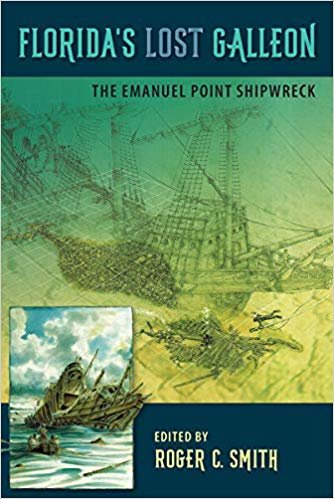Florida’s Lost Galleon: The Emanuel Point Shipwreck
Edited by Roger C. Smith
 The discovery of the Emanuel Point shipwreck in 1992, subsequent field excavation campaigns and field school work, associated historical research, ongoing conservation of recovered artifacts, and public outreach programming all are the substance of this relatively brief and highly readable work. The wreck itself, part of the expedition led by Tristán de Luna to create a settlement in Florida as the starting point for an overland bypass around the treacherous Bahamas Channel, is the earliest to be found to date in the state. The efforts associated with the site also laid the foundations for vibrant subsequent nautical archaeological work undertaken by the Florida Bureau of Archaeological Research, the University of West Florida, and public projects through the Florida Public Archaeology Network.
The discovery of the Emanuel Point shipwreck in 1992, subsequent field excavation campaigns and field school work, associated historical research, ongoing conservation of recovered artifacts, and public outreach programming all are the substance of this relatively brief and highly readable work. The wreck itself, part of the expedition led by Tristán de Luna to create a settlement in Florida as the starting point for an overland bypass around the treacherous Bahamas Channel, is the earliest to be found to date in the state. The efforts associated with the site also laid the foundations for vibrant subsequent nautical archaeological work undertaken by the Florida Bureau of Archaeological Research, the University of West Florida, and public projects through the Florida Public Archaeology Network.
This compilation, edited by Roger C. Smith, of submissions from practitioners intimately involved in the project is very different from many other archaeological reports. The style is personal without glossing over the necessary technicalities, so that the reader is drawn into the project as it unfolds. The various authors manage to convey a palpable sense of the excitement of working on every aspect of this site without in any way diminishing the academic rigor of the presentation. Despite containing pieces from seven contributors, including several with more than one author, there are virtually no jarring transitions, a tribute to the skill of the editor.
The Emanuel Point shipwreck is a very important site, not least because the environmental conditions in Pensacola Bay over the centuries allowed for the survival of an appreciable body of hull structure and a substantial assemblage of artifacts. The hull remains suffice to evidence that this was one of the larger ships of Luna’s fleet, indicate that it was a veteran of the Atlantic passage from Spain to the New World, and demonstrate the drama of the wrecking itself.
Archaeologists have recovered more than five thousand objects from the site and the process of conserving and analyzing this assemblage is ongoing. The historical record shows that survivors of the hurricane that struck the fleet salvaged large amounts of materials and cargo for their survival. What was left behind suffices to tell a compelling story of how the mariners, soldiers, and colonists lived aboard, the necessities they brought with them, and even indications of cargoes carried on previous voyages. Equally education al is the discussion of the conservation processes that enabled the survival and analysis of these objects.
One of the most exciting aspects of this book is its exposition of the programs created to involve the general public, avocational archaeologists, and students in local schools in participating and learning from the various aspects of the work on the discovery.
Florida’s Lost Galleon is a stunning addition to the literature of nautical archaeology. Its combination of accessibility and rigor makes it a model for generating accessible archaeological reportage.
- Gainesville: University Press of Florida, 2018
- 6-1/4” x 9-1/4”, hardcover, xvii + 299 pages
- Illustrations, diagrams, appendix, references, index. $34.95
- ISBN: 9780813056760
Reviewed by Kelly Hanson, University of Southern California
